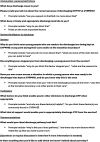Exploring the barriers and facilitators of discharging children and young people from child and adolescent mental health services
- PMID: 40378300
- PMCID: PMC12179414
- DOI: 10.1177/13591045251340490
Exploring the barriers and facilitators of discharging children and young people from child and adolescent mental health services
Abstract
BackgroundThe pressures on community Children and Young People's Mental Health Service (CYPMHS) clinicians to manage and maintain caseloads can be immense, therefore discharging young people from CYPMHS in a safe and timely way is often discussed as a priority. However, there is limited research into how discharge can be done well, especially for discharge occurring prior to children and young people (CYP) reaching the upper age limit of CYPMHS. Thus, this study aimed to gain a better understanding of the barriers and facilitators discharging CYP from community CYPMHS, by exploring clinicians experiences of discharging CYP from their service.MethodSemi-structured interviews of 30-40 minutes were conducted with 12 clinicians working at different CYPMHS in England and analysed using codebook thematic analysis.ResultsSix themes were identified. These included, "perfectionistic approach towards treatment outcomes", "reducing dependence on CYPMHS through empowerment", "a lack of flexibility in the wider system", "lack of collaborative care", "an increasing pressure on the service" and "keeping the focus on discharge".ConclusionClinicians face multiple barriers when discharging CYP which should be addressed, alongside enhancing the use of reported facilitators to ensure timely, safe and well-managed discharges.
Keywords: CYPMHS; Thematic analysis; children and young people; discharge; mental health services.
Plain language summary
Little research has been conducted on the discharge pathway at child and adolescent mental health services (CYMPHS) despite it being the way in which many young people will leave the service. Additionally, the few studies which are present, indicate that discharge is poorly managed and can be delayed. They have also mainly focused on young people who were around 16–18 years old. Thus, this study aimed to gain a better understanding of the discharge pathway, specifically the barriers and facilitators of discharging children and young people across all ages from CYMPHS. The researchers interviewed twelve clinicians from CYMPHS across the UK. We found that multiple barriers affected the ability of clinicians to carry out a timely, and well-planned discharge such as families becoming too attached, a disjointed and inflexible mental health care system, lengthy waiting times, high staff turnover and a lack of focus on discharge planning from the outset. However, there were also some facilitators, which included helping families become self-confident, regular communication with all relevant parties, and using supervision to keep the focus on discharge. The findings of this study can be used to improve the current discharge pathway at CYMPHS, and to hopefully bring attention to this topic which has been so far fairly neglected.
Conflict of interest statement
Declaration of conflicting interestsThe author(s) declared no potential conflicts of interest with respect to the research, authorship, and/or publication of this article.
References
-
- Appleton R., Connell C., Fairclough E., Tuomainen H., Singh S. P. (2019). Outcomes of young people who reach the transition boundary of child and adolescent mental health services: A systematic review. European Child & Adolescent Psychiatry, 28(11), 1431–1446. 10.1007/s00787-019-01307-7 - DOI - PMC - PubMed
-
- Appleton R., Elahi F., Tuomainen H., Canaway A., Singh S. P. (2021). “I’m just a long history of people rejecting referrals” experiences of young people who fell through the gap between child and adult mental health services. European Child & Adolescent Psychiatry, 30(3), 401–413. 10.1007/s00787-020-01526-3 - DOI - PMC - PubMed
-
- Appleton R., Loew J., Mughal F. (2022). Young people who have fallen through the mental health transition gap: A qualitative study on primary care support. British Journal of General Practice: The Journal of the Royal College of General Practitioners, 72(719), e413–e420. 10.3399/BJGP.2021.0678 - DOI - PMC - PubMed
-
- Asen E. (2002). Outcome research in family therapy. Advances in Psychiatric Treatment, 8(3), 230–238. 10.1192/apt.8.3.230 - DOI
-
- Bear H. A., Dalzell K., Edbrooke-Childs J., Garland L., Wolpert M. (2021). How to manage endings in unsuccessful therapy: A qualitative comparison of youth and clinician perspectives. Psychotherapy Research: Journal of the Society for Psychotherapy Research, 32(2), 249–262. 10.1080/10503307.2021.1921304 - DOI - PubMed
MeSH terms
LinkOut - more resources
Full Text Sources
Medical


